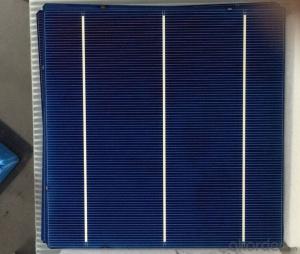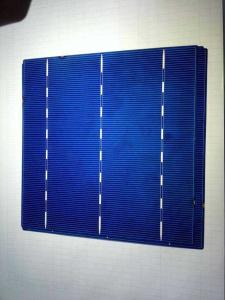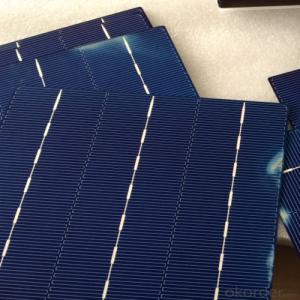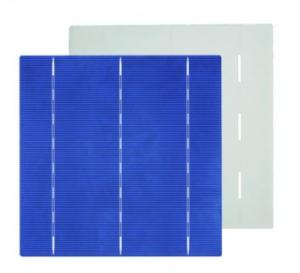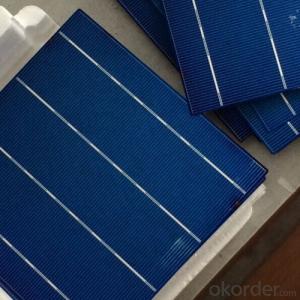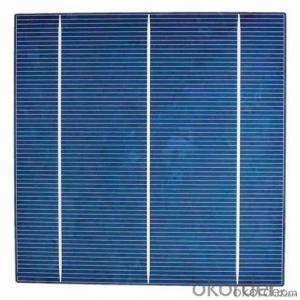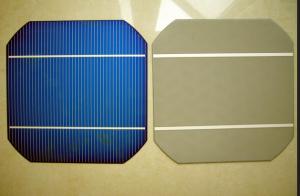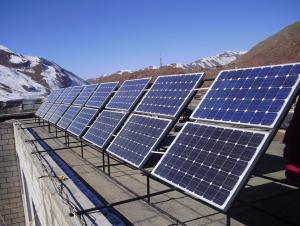Screen Printed Solar Cells - Poly 3BB with Lower Price AB Grade
- Loading Port:
- Shanghai
- Payment Terms:
- TT or LC
- Min Order Qty:
- 30000 pc
- Supply Capability:
- 1000000 pc/month
OKorder Service Pledge
OKorder Financial Service
You Might Also Like
Electrical Characteristic
Efficiency (%) | Pmpp (W) | Umpp (V) | Impp (A) | Uoc (V) | Isc (A) | FF (%) |
17.25 | 4.197 | 0.524 | 7.992 | 0.62 | 8.458 | 80.03% |
17 | 4.137 | 0.524 | 7.876 | 0.619 | 8.353 | 80.01% |
16.75 | 4.076 | 0.522 | 7.81 | 0.617 | 8.286 | 79.73% |
16.5 | 4.015 | 0.518 | 7.746 | 0.613 | 8.215 | 79.73 |
16.25 | 3.955 | 0.515 | 7.683 | 0.61 | 8.144 | 79.61% |
16 | 3.894 | 0.512 | 7.613 | 0.608 | 8.075 | 79.31% |
15.75 | 3.833 | 0.51 | 7.534 | 0.605 | 8.058 | 78.62% |
15.5 | 3.772 | 0.508 | 7.453 | 0.604 | 8.02 | 77.87% |
15.25 | 3.771 | 0.505 | 7.35 | 0.604 | 9.997 | 76.83% |
15 | 3.65 | 0.503 | 7.271 | 0.604 | 7.989 | 75.64% |
14.5 | 3.529 | 0.499 | 7.067 | 0.604 | 7.988 | 73.14% |
14 | 3.407 | 0.499 | 6.833 | 0.604 | 7.833 | 72.01% |
Intensity Dependence
Intensity [W/m2] | Isc× [mA] | Voc× [mV] |
1000 | 1.00 | 1.000 |
900 | 0.90 | 0.989 |
500 | 0.50 | 0.963 |
300 | 0.30 | 0.939 |
200 | 0.20 | 0.920 |
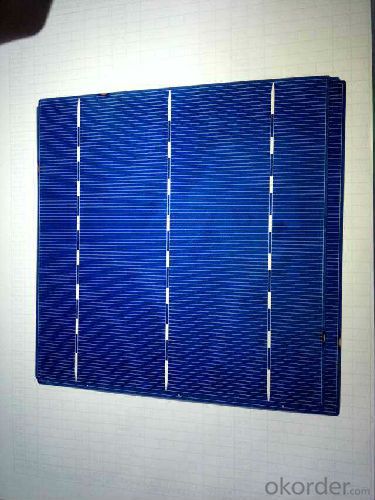
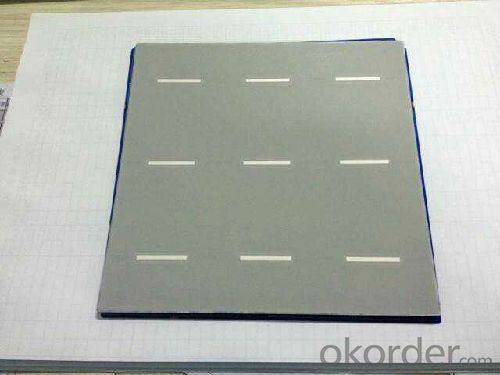
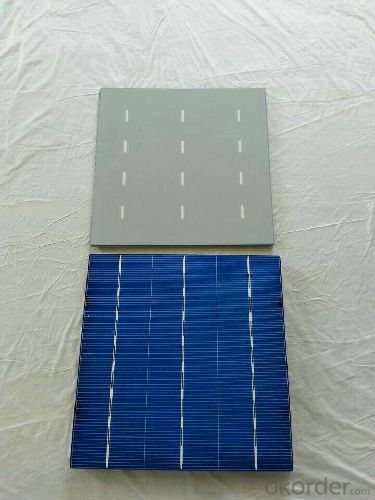
Advantage Of Poly Solar Cell 156mm
1: High quality cell, Level A cell (14%—17.5%)
2.Dimensione:156*156mm Diagonal:200mm
3: Qualified certification: TUV,CE certification.
4: Warranty: five years for whole unit
Photovoltaic cells are made of special materials called semiconductors such as silicon, which is currently used most commonly. Basically, when light strikes the cell, a certain portion of it is absorbed within the semiconductor material. This means that the energy of the absorbed light is transferred to the semiconductor. The energy knocks electrons loose, allowing them to flow freely. The third generation of solar cells includes a number of thin-film technologies often described as emerging photovoltaics—most of them have not yet been commercially applied and are still in the research or development phase. Many use organic materials, often organometallic compounds as well as inorganic substances. Despite the fact that their efficiencies had been low and the stability of the absorber material was often too short for commercial applications, there is a lot of research invested into these technologies as they promise to achieve the goal of producing low-cost, high-efficiency solar cells.
- Q: Are there any books in the market t about solar cells and their applications?
- You can try to search online about the application of solar cells.
- Q: What is the impact of solar cells on reducing noise pollution from power generation?
- Solar cells have a positive impact on reducing noise pollution from power generation as they operate silently, without the need for noisy machinery or moving parts.
- Q: Can solar cells be used for disaster relief efforts?
- Yes, solar cells can be used for disaster relief efforts. They provide a reliable source of clean energy, which can be crucial in situations where traditional power sources are disrupted or unavailable. Solar cells can be used to power emergency communication systems, medical equipment, lighting, and water purification systems, among other essential needs in disaster-stricken areas. Additionally, portable solar panels can be easily deployed to remote locations, making them an ideal solution for providing immediate power during relief operations.
- Q: What is the most commonly used material for solar cells?
- It is mainly the crystalline silicon materials (including polysilicon and monocrystalline silicon), its market share in more than 90% and in the future for a long period of time will still be the main material of solar cells.
- Q: Can solar cells be used in harsh climates?
- Yes, solar cells can be used in harsh climates. While extreme temperatures, snow, and dust can potentially affect the efficiency and performance of solar cells, advancements in technology and design have made them more resilient. Specialized coatings, materials, and mounting systems are employed to protect solar cells from harsh weather conditions. In fact, solar panels are increasingly being used in various extreme climates around the world, including deserts and polar regions, proving their adaptability and effectiveness even in challenging environments.
- Q: Can solar cells be used to power electric vehicles?
- Yes, solar cells can be used to power electric vehicles. Solar cells can convert sunlight into electricity, which can then be used to charge the batteries of electric vehicles. This technology is being explored and implemented in various forms, such as solar panels integrated into the roof or body of the vehicle, to provide additional power and extend the range of electric vehicles.
- Q: How do solar cells perform in areas with extreme temperature fluctuations?
- Solar cells can be affected by extreme temperature fluctuations. High temperatures can cause solar cells to become less efficient and generate less electricity, while very low temperatures can reduce their ability to function optimally. However, advancements in technology and the use of materials that are more resistant to temperature changes have improved the performance of solar cells in areas with extreme temperature fluctuations. Additionally, proper installation and maintenance can help mitigate the impact of temperature fluctuations on solar cell performance.
- Q: How do solar cells affect the environment?
- Solar cells have a positive impact on the environment as they generate electricity from a renewable source, the Sun, without emitting greenhouse gases or harmful pollutants. This reduces reliance on fossil fuels, mitigates air and water pollution, and contributes to the fight against climate change. Additionally, solar energy does not require water for operation, which helps conserve this precious resource. Although there are some environmental concerns related to the production and disposal of solar cells, the overall benefits greatly outweigh these drawbacks.
- Q: Can solar cells be used in shopping malls?
- Yes, solar cells can be used in shopping malls. They can be installed on the rooftops or in parking areas to generate clean and renewable energy for the mall's operations. This can help reduce electricity costs and carbon footprint while promoting sustainability.
- Q: What is the expected degradation rate of a solar cell?
- The expected degradation rate of a solar cell can vary depending on various factors such as the type of solar cell, the quality of materials used, the environmental conditions, and the maintenance practices. On average, however, most solar cells experience a degradation rate of around 0.5% to 1% per year. This means that the efficiency of the solar cell decreases by this percentage over time. Proper maintenance and regular cleaning can help mitigate degradation and extend the lifespan of a solar cell.
Send your message to us
Screen Printed Solar Cells - Poly 3BB with Lower Price AB Grade
- Loading Port:
- Shanghai
- Payment Terms:
- TT or LC
- Min Order Qty:
- 30000 pc
- Supply Capability:
- 1000000 pc/month
OKorder Service Pledge
OKorder Financial Service
Similar products
Hot products
Hot Searches
Related keywords
